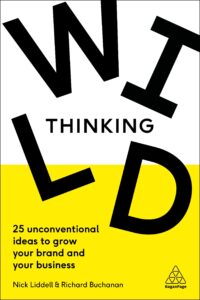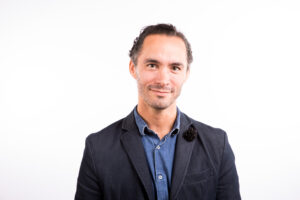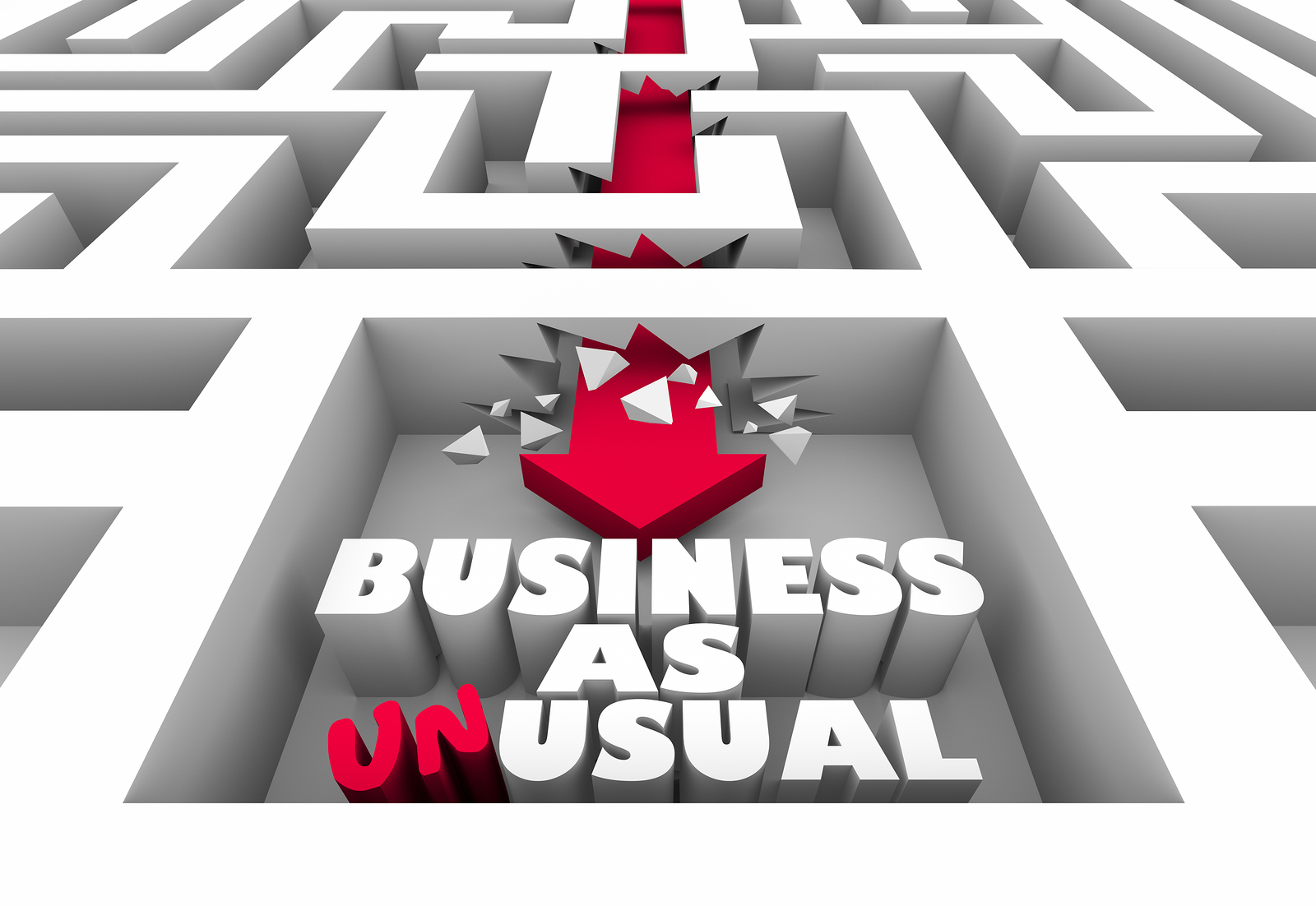Ideas to Grow Your Brand
Study some of the most interesting and diverse group of companies such as Google, Twinings, Dropbox and even Wimbledon and you end up with fascinating stories, case studies, and research useful to every brand. The Clearing is a brand consultancy helping global brands grow and make a difference. Nick Liddell is Director of Consulting and Richard Buchanan is Managing Director and a founding partner. I spoke with Nick about their research and their book, WILD THINKING: 25 Unconventional Ideas To Grow Your Brand and Your Business .
25 Provocative Questions to 25 Creative Leaders
What is wild thinking?
Wild thinking is what happens when you pose 25 thought-provoking questions to 25 intelligent, creative leaders in organizations as diverse as Google, Gap, Time Out and Twinings. We worked with philosophers at The School of Life to develop a set of questions capable of helping people to uncover deeper truths about their organizations, their brands and their own professional motivations: questions like, “Which of your brand’s flaws have you learned to ignore?” and “What could you eliminate from your business today that you suspect no one would miss?” Then we paired each question with an inspirational person, chosen from a deliberately diverse pool of sectors – both for-profit and not-for-profit. The result is a set of refreshingly candid and original perspectives on pretty much every aspect of working life – from how we define success to how we establish positive, productive cultures where emotional honesty is appreciated.
Don’t Sabotage Your Brand
Your book poses thoughtful questions. Which one are you finding more people surprised by?
The opening question is the most surprising – and it’s the one question in the book we pose directly to the reader: “Which person at work is most effective at sabotaging your brand? Maybe it’s you.” The book is best approached with an open mind and a degree of humor and humility. We don’t pretend to have all the answers, which is why we’ve sought out the opinions of people who are far more intelligent and imaginative than ourselves. The idea is that over the course of the book some of the brilliance rubs off and bit by bit we get a little smarter and a little less likely to undermine our own efforts to make a success out of work.
A Successful Career is a Marathon
When you study the world’s brands, what is one lesson that you’ve found executives the most surprised to learn?
There’s a chapter that asks where you look for inspiration outside of the world of business. It begins with this caricature we’ve built up of the modern CEO: someone who sleeps for three hours before waking at five a.m. so they can hit the gym, clear their inbox, meditate and drop the kids off at school before the rest of us mere mortals have had a chance to stumble blearily out of bed. It’s a really discouraging stereotype and fuels a tremendous amount of paranoia among senior people in the workplace that they are inadequate, or impostors waiting to be found out. But once you get beyond that stereotype, there are some really encouraging examples of senior people who have enjoyed long careers because they have cultivated a broader set of interests and passions. It’s easy to forget that a successful career is a marathon, not a series of short and exhausting sprints, but seeing work life this way takes away some of the pressure to contort yourself into some weirdly obsessive corporate athlete.
What are some of the biggest mistakes leaders make in terms of their brand?
 A couple of stories stand out here. We spoke to John Allert at McLaren about his brand’s nemesis. Most people – particularly those who follow Formula 1 – assume that the answer is Ferrari, but John believes that the real enemy his organization battles on a daily basis is mediocrity. This is far more of an existential threat to the business than even its fiercest rival. And I think there’s a really big lesson in there: brand owners often become so distracted by external competition that they overlook the hidden enemy within. For some brands that’s complacency. For others it’s complexity. But these are usually far more significant barriers to growth than any competitor – disruptive or otherwise.
A couple of stories stand out here. We spoke to John Allert at McLaren about his brand’s nemesis. Most people – particularly those who follow Formula 1 – assume that the answer is Ferrari, but John believes that the real enemy his organization battles on a daily basis is mediocrity. This is far more of an existential threat to the business than even its fiercest rival. And I think there’s a really big lesson in there: brand owners often become so distracted by external competition that they overlook the hidden enemy within. For some brands that’s complacency. For others it’s complexity. But these are usually far more significant barriers to growth than any competitor – disruptive or otherwise.
Another common issue we’ve identified is a failure to articulate a simple, single-minded point of difference – what we call a ‘Clear Defendable Territory.’ It’s about more than just writing a lovely purpose statement about how you want to make the world a better place. Anybody can do this. And many organizations have. But real clarity comes when you can list the rules you’re prepared to break, or the wisdom you’re prepared to subvert to achieve your goals. We spoke to the Michelin-starred chef Tom Kerridge about his brand. He operates in a world where craft and artistry are real positives. His ambition is to be precisely the opposite of what other Michelin-starred chefs aspire to be: creative and artistic. He describes his cooking as lazy and unimaginative, but with the redeeming quality of being honest and simple. He sees cooking as a trade rather than an art, which makes his food more accessible and less intimidating. Few brands benefit from that level of clarity.
What are some practical ways that leaders can make empathizing with customers part of the brand strategy?
There are a couple of conversations in the book that touch on the idea of empathy. We spoke to Juliet Slot at Ascot about how to deliver a truly exceptional customer experience. She’s pretty well placed to talk about this as the Queen is one of her customers. But her insight is that you can’t just seek to empathize with your customers. You have to begin with the people who you rely on to deliver to those customers – your colleagues. This is where a lot of well-meaning organizations go wrong: they talk about being customer-focused, or even customer-obsessed, in a way that relegates colleagues to the status of second-class citizen. Brand becomes an external veneer rather than a motivating force for cultural change. When Ascot re-branded, they invested a tremendous amount of time and effort in involving, informing and inspiring colleagues and contractors. Only after a year did the customer begin to see the brand evolve, but the resulting change was more genuine, more sustainable and more sensitively delivered than a classic ‘customer-first’ approach would have delivered.
The second conversation touched on how people deal with uncertainty and anxiety in the workplace. We spoke to Liz Warner, the Chief Executive of Comic Relief, about emotional honesty in the workplace – including caring and crying at work. It’s a subject many of us feel profoundly uncomfortable with, but Liz has an enormous degree of emotional openness and is just as comfortable having difficult conversations as she is telling positive stories about passion and purpose. Her interview is a vivid demonstration that empathy doesn’t just begin inside an organization – it really needs to come from the top.
You have many provocative questions and prompts to spur excellent conversations in leadership teams. Let me share one so readers understand: “What’s the smallest detail you can think of that makes the biggest difference to how your brand is perceived?” Share a little more about this one.
Ha! Yes – that’s a conversation we had with Mick Desmond, Commercial and Media Director at the All England Lawn Tennis Club, which is responsible for organizing the Wimbledon tennis championships. The brand is driven by the pursuit of greatness and its attention to detail is absolutely astounding. Wimbledon’s grass courts are re-seeded each year and cut precisely to the optimum playing height of 8 mm about a month before The Championships begin, and re-mown at this level every morning of the fortnight. Loose dust and grass kicked up by players’ feet are vacuumed away. A pair of Harris hawks patrol the skies above the courts from 5 am to 9 am to keep away pigeons. The optimal size of a Wimbledon strawberry is between 25–45 mm, so that people can enjoy their strawberries and cream without needing to cut the strawberries. Every last detail has been designed to convey the desired impression of tennis in an English garden. Understandably, a lot of business books focus on how to get strategy right. Strategy is complex and sexy. But Wimbledon demonstrates how important it is to get the details right. Every year, people around the Club compile a list of all the areas they can improve upon to deliver a better experience. Some of these involve large capital infrastructure projects – these find their way into a long-term Masterplan for investment. But the smaller details aren’t lost. They find their way onto a separate list, which is then broken down into tasks that are allocated across teams so everybody is clear on what they need to improve over the coming year. So much attention is focused on disruption and radical change, that it’s easy to forget that the ability to delight often comes through gradual improvement and getting all of the little things just right.
Purpose is Pointless without Pleasure
You end your book with this: “Purpose is pointless without pleasure.” Would you share a little about your ending point?
 Absolutely. There’s a tremendous body of management and marketing literature focused on the importance of purpose to organizational success. Writers like Jim Collins and Simon Sinek have inspired a generation of leaders to articulate a bigger, broader social mission for their organizations – the “why” that explains the role their company plays beyond the pursuit of profit. The point we make in the final chapter is that purpose alone isn’t enough. Research conducted by Professor Paul Dolan at the London School of Economics suggests that happiness lies in balancing purposeful activities with pleasurable activities. Work is often purposeful, but not necessarily pleasurable. That means that if we want people to be happier, we either need to make sure they strike a better balance between “purposeful” work and “pleasurable” leisure activities, like watching TV, socializing or playing sports, or we need to make work pleasurable as well as purposeful. This goes beyond the banal form of corporate-sponsored fun practiced by many organizations – bean bags, dress-down Fridays and pool tables. It’s more fundamental than that. It’s about the manner in which you choose to work. The businesses and brands that people admire the most aren’t those with the noblest purposes – they are those that achieve their goals in compelling style. People aren’t obsessed with Southwest Airlines because of its brand purpose. Most people who fly with them wouldn’t be able to tell you what its purpose is. But they would tell you that they are unbelievably warm and accommodating. It’s not that organizational purpose doesn’t matter, but it works best when it’s achieved in the most pleasurable way possible.
Absolutely. There’s a tremendous body of management and marketing literature focused on the importance of purpose to organizational success. Writers like Jim Collins and Simon Sinek have inspired a generation of leaders to articulate a bigger, broader social mission for their organizations – the “why” that explains the role their company plays beyond the pursuit of profit. The point we make in the final chapter is that purpose alone isn’t enough. Research conducted by Professor Paul Dolan at the London School of Economics suggests that happiness lies in balancing purposeful activities with pleasurable activities. Work is often purposeful, but not necessarily pleasurable. That means that if we want people to be happier, we either need to make sure they strike a better balance between “purposeful” work and “pleasurable” leisure activities, like watching TV, socializing or playing sports, or we need to make work pleasurable as well as purposeful. This goes beyond the banal form of corporate-sponsored fun practiced by many organizations – bean bags, dress-down Fridays and pool tables. It’s more fundamental than that. It’s about the manner in which you choose to work. The businesses and brands that people admire the most aren’t those with the noblest purposes – they are those that achieve their goals in compelling style. People aren’t obsessed with Southwest Airlines because of its brand purpose. Most people who fly with them wouldn’t be able to tell you what its purpose is. But they would tell you that they are unbelievably warm and accommodating. It’s not that organizational purpose doesn’t matter, but it works best when it’s achieved in the most pleasurable way possible.
For more information, see WILD THINKING: 25 Unconventional Ideas To Grow Your Brand and Your Business .

